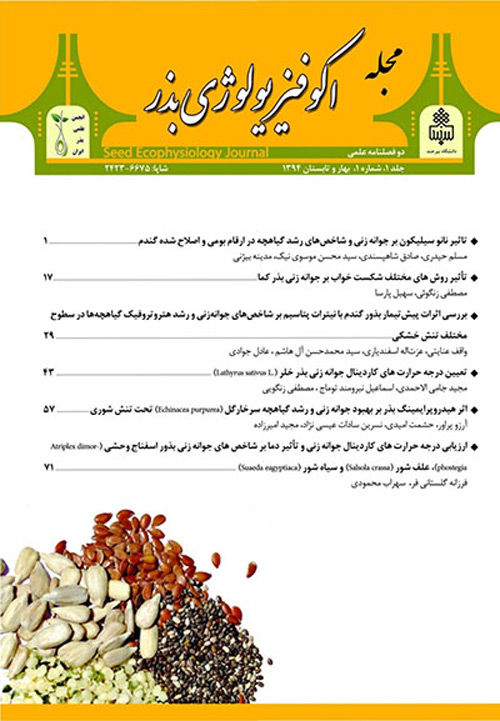The effect of hormonal priming on seed germination and seedling growth of cumin (Cuminum cyminum L.) Birjand landrace under salinity and drought stress conditions
Cumin is an annual, herbaceous and aromatic plant that belongs to Apiaceae family. Leaf shape and short shrubs, color and surface coating of plant organs, are all indicative of adaptation of Cumin to areas with dry climate. Seed priming is one of the most effective methods to improve seed germination and seedling establishment, especially in unfavorable environmental conditions. The aim of this study was to evaluate the effect of gibberellic acid on germination and seedling growth characteristics of cumin under salinity and drought stress conditions.
Factorial experiment in a completely randomized design with three replications was conducted in the seed laboratory of University of Birjand in April 2016. Experimental factors were included salinity (sodium chloride) and drought (using polyethylene glycol) in three levels with the same potentials (zero, -0.75,-1.5 MPa) and seed priming using gibberellic acid (GA3) at three levels: zero, 50 and 100 ppm. The seeds are disinfected with sodium hypochlorite 10% for 30 seconds and then washed several times with distilled water and contamination effects were not observed during the test. Then 20 similar seeds were placed in Petri-dishes with 9 cm diameter and 5/1 cm height with filter paper, incubated in 15 °C temperature. Natural seedlings with whole root, plumule and leaves and also normal color and size, were separated from abnormal seedlings, according to International Seed Testing Association and various characteristics such as germination percentage, germination rate, seedling fresh weight, seedling dry weight, seedling length, shoot length, root length, length and weight vigor index, were measured.
The results showed that have significant effect the main and interaction effects of salinity and gibberellic acid, except seedling dry weight on the germination characteristics like percentage and rate of germination, vigor index, shoot and root length (P≤0.01). Most seedling length, corresponding to the first salinity level and second gibberellic acid level, with 1.5% increase, compared to control and the lowest level was related to the third level of salinity and the first level of gibberellic acid was a reduction of 100%, compared to the Control. The highest root length was achieved at the first level of salinity and the second level of gibberellic acid that increasing 6.3 percent compared to the control and the lowest value of mentioned trait was observed in the first level of gibberellic acid in the third level of salinity with the reduction of 100%, compared to the control. The interaction between drought and gibberellic acid had no significant effect on seed vigor, root and shoot length, but the main effect of drought and gibberellic acid was significant on fresh and dry weight, rate and percentage of germination (P≤0.05 ) .Maximum rate of germination in dry condition was related to the first level of drought and the second level of gibberellic acid. It seems that gibberellic acid was synthesized in embryonic axis during the germination process, directly affect the speed of germination and heterotrophic growth of seedlings by stimulating the production of hydrolytic enzymes and degradation the storage nutrients. Also the most germination percent was at the drought and gibberellic, While the Second drought and gibberellic acid levels by reducing 1.6% as compared to control had lowest percentage of germination. Maximum root length, on level two drought and a gibberellic acid decreased 7.7 percent as compared to Control. The most of plant dry weight of level dryness first and third, gibberellic acid and lowest Second level dryness and second gibberellic acid showed 90 percent reduction compared to control. Group comparisons showed that between the two studied stresses With the equal gibberellic acid levels, inhibitory and negative effects of salinity on evaluated traits were more strongly than drought, which this issue is related to special effects of salinity in disrupting the balance of nutrients in the growth medium and particularly toxicity of ions.


